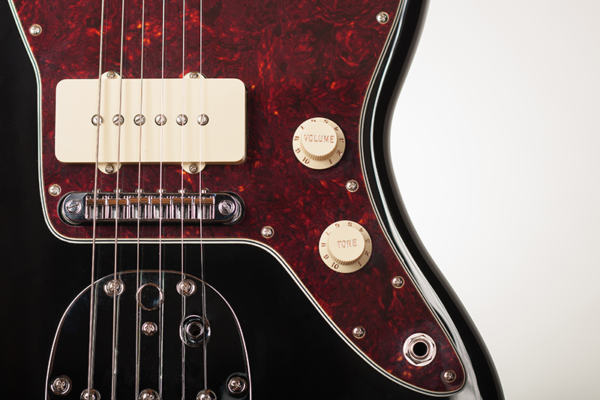How the 1/4 Connector Wound Up on Guitars and Created Our Modern Sound
Few sounds are more emblematic than a guitarist plugging in. The crackles, followed by a hum and a satisfying snap, build anticipation for the sweet cacophony of an electrified six-string being strummed. The process is so ingrained in our concept of Rock n’ Roll that its presence is a fundamental component of modern music, especially live performances. Thanks to the 1/4-inch connector.
While the guitar plug, or 1/4-inch connector, is recognizable to almost anyone, the reason it came to be and wound on electric guitars is a mystery to most folks. The true story involves a revolution in late 19th-century communication, the colonial deposing of a Hawaiian queen, and a cultural phenomenon that swept the US twice. The point where these events come together sent shock waves through musicians, forever altering music’s sound, shape, and reach, creating our modern world.
From Communication to Chords
The 1/4-inch connector, known to audio pros as a TRS (Tip/ Ring / Sleeve) or TS ( Tip/ Ring), is more commonly known for wired headphones and guitars – respectively in that order. While still ubiquitous in the professional world, it has begun to fall out of favor as the convenience of wireless systems take over.
Cylindrically shaped with a flared head and concentric rings at the top, the unit was first introduced in the mid-1800s to manage multiple telegraph lines and, shortly after, the nascent telephone exchanges. If you have ever watched movies from the 1930s and 40s, it is likely the scenario of an operator interceding a call and then manually inserting these wired connectors into a patch bay played out. The process effectively minimized electrocuting users and protected the equipment.
1/4-inch connector evolves
Until automated systems became commonplace in the latter half of the 20th century, the process enabled a single station to route calls while preserving intelligibility over long distances. The “Jack Knife” (so called as the early versions had a wooden handle reminiscent of pocket knives) was inserted into a spring clip that made contact with the tip and ring – thereby allowing point A to chat with point B. To prevent the local and remote power sources from shortening out, the tip (initially a ball and later the familiar tapered cone shape) pushed one tab clear before settling into the socket. The process effectively minimized electrocuting users and projected the equipment.
From an Overrthow To (Musical) Revolution
Around the same time as the telegraph and telephone changed the social and economic fabric of the US, a small island nation in the middle of the Pacific was thrown into turmoil and tumult. Hawaii was long desired, not for its beautiful beaches, rolling waves, and exotic dances (this would come later), but for its lands perfect for growing sugar cane and as a halfway point for trade with Japan, China, and Oceania.
After years of struggle where power and control danced between US industrialists and the monarchy, Queen Lili’uokalani was arrested by US Marines at the urging of American businessman and militia leader and aspiring robber baron Lorrin Thurston. At the time, the Queen attempted to refocus power to the monarchy by promoting a new constitution that limited corporate land possession, minimized missionaries, and opened expansive voting rights for citizens. Amid this, an aspiring musician named Joseph Kekuku developed an instrument that changed how artists played and forever altered existing music genres.
Spanish To Steel, The Brith of the Kila Kila
The Kika Kila, often called a Hawaiian or steel guitar, came into being when Kekuku experimented by raising the strings on an old Spanish guitar and using a bar to slide along the strings. The instrument is laid on a person’s lap rather than the traditional method of strumming strings while held horizontally across the body.

Using multiple finger picks (like those used by banjo players), the guitar produces perceptually louder tones that glide seamlessly from note to note while generating a sinuous wailing sound, often compared to a singing voice. The sound of the Kika Kila and the rhythmic pounding of Pahu and Kilu drums are instantly synonymous with Hawaii.
1/4-inch Connector Invades
In 1915, the construction of the Panama Canal was completed, and its opening to traffic was followed by a seven-month-long celebration (called The Panama Expo) in San Francisco. Among those sent to represent all of the Americas were Joesph Kekuku and his collection of Hawaiian performers. Shortly after their arrival, the group performed for a radio broadcast sent from coast to coast; the event set off clamoring to hear more from Seattle to New York City and all points in between.
In relatively quick order, Kekuku’s group and others recruited from the islands flooded into the US, traveling with vaudeville shows; many paid handsomely to have a band with the new sound on their rosters. Early blues musicians and country swing bands found inspiration in the slightly ethereal, exotic, and emotive sounds, quickly incorporating and adapting the techniques using beer bottlenecks and finger slides and eventually morphing into the steel pedal guitar.
Louder, Stronger, Brining The Guitar To The Forefront
The fanatical attraction to the steel guitar went beyond the unique and expressive playing or novelty. As the Kika Kila faced upwards, it gave vigor to the music, giving the instrument more presence in a space.
While guitars (initially created for parlor entertainment) flourished with small bands or as a solo, they often had trouble finding a place in larger groups. Relegated to melody or employed as an accent or complement, strings became overwhelmed by horns, woodwinds, and percussion. The quest to develop an instrument and accessories, bringing guitars to the forefront, occupied engineers and musicians alike.
Early attempts to increase the apparent loudness included replacing gut with steel strings (requiring additional support in the body that continues to this day), placing specialized megaphones in front, and instruments with built-in resonators. The latter, resophonic guitars (including many Kika Kilas), incorporated metal cones, resulting in a louder and more distinctive sound.
Beauchamp Goes Electric, Beats Dylan by 35 Years

George Beauchamp performed for vaudeville shows, playing lap steel guitar and violin for audiences across America. Before founding the National Stringed Instrument Corporation, Beauchamp collaborated with John Dopyera to develop some of the first resonator instruments.
While successful, Beauchamp’s early experiments in electrifying his Kika Kila left him less than satisfied with the sound of phone carbon microphones often employed for this. Teaming up with Aldoph Rickenbacker, an expert machinist and owner of a premier machine shop, they produced the first commercially viable single-coil pickups.
Bring on the OG 1/4-inch Connector

Rather than return to using woefully underpowered phonograph parts or modified radio/ PA systems, the team developed their own. Rickenbacker and Beauchamp incorporated many of the parts used in the phone switching systems mentioned earlier (the studio patch bays can draw a straight line back to the 1800s originals.)
All of this led to the development of the Rickenbacker Electro A-22, the world’s first electric guitar. The guitar, Nicknamed the ‘Frying Pan’ as the body resembled a cast iron pan, was, in fact, a lap steel guitar, or Kika Kila. Hooking the instrument to an amplifier was made with another telephony-based connector, the humble 1/4-inch connector. Nearly a hundred years later, musicians from folk to shred metal continue to plug in the same way.

George Tucker
As part of the AV community, Tucker has over 30 years of experience working for professional recording studios, live event production, residential and commercial integration, Broadway tour support, technology writing, automation programming, and as a tech support manager for premier automation manufacturers.
George’s connection with AVNation goes back to the beginning, collaborating on Episode 0000 of AV Week and acting as host, producer, and general bon vivant over the first seven years. Currently, he is a Technical Specialist for a live events company. He enjoys deep dives into new music and perfecting the perfect Bloody Mary on his off time.








